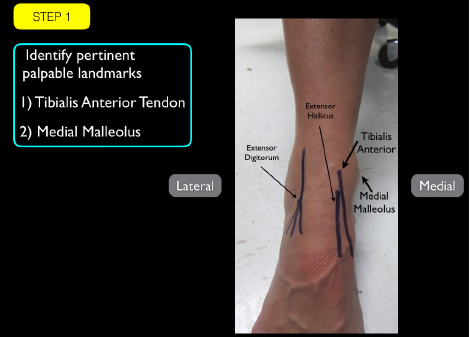Septic arthritis of the ankle is an uncommon but devastating clinical entity representing 3 percent to 14 percent of all septic arthritis cases.1 Diagnostics can prove challenging, especially because systemic symptoms like fever and chills are present in fewer than 50 percent of cases. This forces clinicians to rely on nonspecific and often insensitive physical exam findings, such as pain with joint movement and axial loading.
Explore This Issue
ACEP Now: Vol 39 – No 01 – January 2020In cases of clinical suspicion of a joint infection, point-of-care ultrasound (POCUS) is an ideal bedside tool to determine the presence of joint capsule effusion. Also, POCUS allows a safe and simplified method for joint aspiration.1–3
Ultrasound Examination of the Ankle
Using POCUS for ankle joint assessment starts with good positioning. Place the patient in the supine position with their foot in mild plantar flexion so that the sole rests against the bed. If possible, palpate the anterior tibialis tendon on the anteromedial aspect of the foot. This landmark is easily noted in most patients and acts as an easy starting point when using ultrasound to evaluate the tibiotalar joint.

PHOTOS: Arun Nagdev
The goal is to image just under the anterior tibias tendon or just medial to it. The space between the anterior tibias tendon and medial malleolus is free from tendons or arteries, allowing for an unobstructed evaluation of the ankle joint as well as a safe location for aspiration. We recommend using a high-frequency linear transducer because of the shallow depth of the tibiotalar joint (see Step 1).
We also recommend imaging the nonaffected ankle first to determine a true normal. Place the transducer over the distal tibia (with the probe marker oriented caudally) and visualize the bright hyperechoic line of its bony cortex. Slowly slide the transducer toward the ankle until you are over the space between the tibia and talus (see Step 2). A joint capsule effusion will be an anechoic (dark) fluid collection just above the tibiotalar joint and is clearly seen on ultrasound. A superficial cellulitis and/or abscess can be easily differentiated from a deep joint effusion due to its location close to the probe and connection to the overlying skin (see Step 3).
In patients with an obvious effusion of the joint capsule overlying the tibiotalar joint, the clinician can progress to performing the ultrasound-guided aspiration or call a consultant for assistance. Clinical judgment is needed to determine the need for aspiration because other noninfectious entities can produce joint capsule swelling (eg, gout, arthritis, etc.).
Pages: 1 2 3 | Single Page




No Responses to “Using Point-of-Care Ultrasound to Evaluate and Aspirate Ankle Infections”